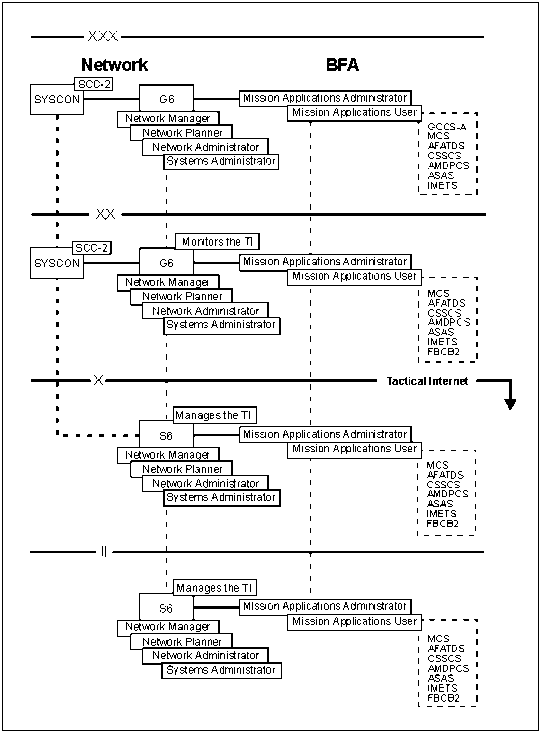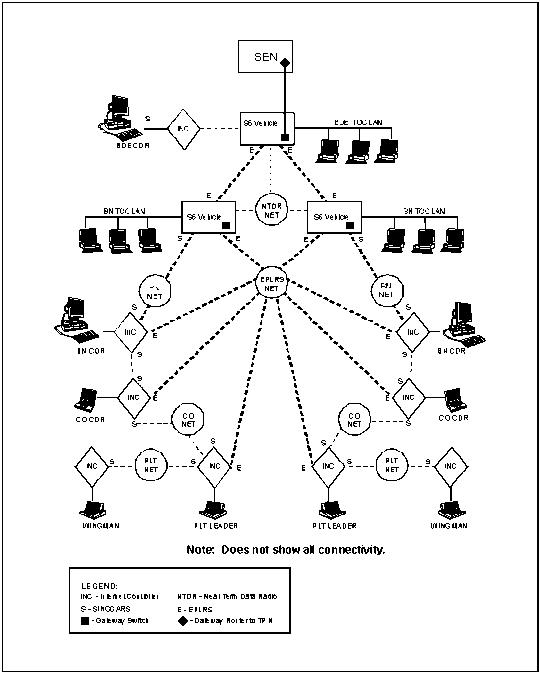Chapter 4
Network and Systems Management Hierarchy
A well-managed network or system ensures reliable and efficient communications to support the commander. The hierarchy of network and systems management facilitates the areas of responsibility of the WAN, TOC LAN, and the TI. This chapter covers the WAN, TOC LAN, network management, information management, and the TI at brigade and below.
WAN
4-1. The WAN consists of the following networks-
- MSE (ACUS) network.
- Global broadcast service (GBS) network.
- Near-term data radio (NTDR) network. (The Joint Tactical Radio System (JTRS) will replace the NTDR.)
4-2. The signal brigade headquarters conducts management and control in an MSE corps network. The supporting signal brigade/battalion provides configuration, performance, accounting, security communications, and fault management. The TOC LAN must connect to the SEN to communicate with higher, lower, and adjacent units. The SEN serves as the gateway to the WAN. Appendix C provides more information on MSE support.
TOC LAN
4-3. Each unit uses a TOC LAN to share information among the linked computers and other LANs. Gateways provide a connection to other LANs or WANs. The unit TOC LAN provides-
- File sharing and transfer.
- Application sharing and accessibility.
- Printer sharing.
- Security.
4-4. The unit installs, operates, and maintains all information systems connectivity requirements and peripherals within the TOC area. The deputy G6 and/or S6 plan, configure, manage, and maintain the unit's TOC LAN. Under the direction of the TOC noncommissioned officer in charge (NCOIC), the personnel install the unit's TOC LAN. The signal offices assist with and provide technical support in the installation of the TOC LAN.
4-5. The deputy G6 and/or S6 ensure connectivity to the supporting SEN. The supporting signal brigade/battalion and the G6/S6 share the responsibility to configure, operate, and maintain connectivity of the TOC LAN to the WAN. Figure 4-1 shows the WAN/LAN area of responsibility.

Figure 4-1. WAN/LAN Area of Responsibility
NETWORK MANAGEMENT
4-6. The corps and division signal battalions deploy their MSE signal assets under the overall direction of the corps signal brigade. The corps signal brigade SYSCON manages and controls the corps MSE network using the SCC-2. The SCC-2 performs all automated network planning, management, and control for the corps. The corps signal brigade maintains network integrity, coverage and service. The division SCC-2 functions in an active role but remains under the technical control of the corps' active SCC-2 (Figure 4-2). In a division stand-alone configuration, the division SCC-2 assumes these functions and responsibility for the division network elements. SYSCON begins managing signal resources that support the TOC LANs on which the information systems operate.
4-7. Signal support organizations exist at every echelon to support the commander. These organizations provide reliable and flexible communications, automation, and information services. Effective network management provides an efficient and rapid means of retrieving information and enabling the battle staff to develop and maintain a single, virtual (or logical) database. This allows battle staffs to continue coordinating, integrating, and synchronizing current and future information operations. Network management ensures information systems, LANs, and WANs integrate into a single and seamless system.
4-8. The base requirement for establishing and controlling communications remains from higher to lower, left to right, supporting to supported, and reinforcing to reinforced. The element in the higher, left, or supporting category coordinates frequency plans, COMSEC keys, software, and edition and control mechanisms. Figure 4-2 shows the hierarchy from corps, division, brigade, and battalion. It indicates the network management hierarchy of communications, networks, and management elements.
CORPS
4-9. The corps signal brigade provides support through the corps area common-user network providing management and control in an MSE corps network. It provides special staff and technical assistance for planning and controlling all corps signal functions and the extension of signal services to higher and adjacent commands. MSE is the principal corps common-user system providing reachback capabilities and connectivity to subordinate divisions, adjacent units, and joint and allied services.
4-10. The corps G6, as a staff planner, plans for adequate and continuous area coverage throughout the corps area. In the division area, the organic four or six nodes often require augmentation. The corps G6 provides the assets needed to ensure area coverage. Normally, this requires two nodes. Allocation to the division depends on corpswide commitments. The division G6 employs his assets to support the C2 needs of the division. He has direct control of overall network assets and planning within the division switching control group. The corps SYSCON provides centralized control of the MSE network and is responsible for installation and operation. The division SYSCON works closely with the corps SYSCON for effective technical control.
4-11. In a corps network, each division SCC-2 controls the planning, engineering, and executing of all signal support requirements and assets within the division switching control group. The corps SCC-2 provides technical control for the integrated corps network while assisting the divisions.

Figure 4-2. Network and Systems Management Hierarchy
DIVISION
4-12. The division signal battalion is the principal signal organization supporting the division. The battalion's primary mission is to establish a division area common-user network. The signal battalion also provides signal support and staff assistance to plan and control division communications, automation, visual information, and information systems.
4-13. The division signal battalion headquarters conducts management and control in a stand-alone division MSE network. Within these headquarters, SYSCON conducts MSE network planning and operation. SYSCON maintains technical control of the network and-
- Plans, engineers, controls, and maintains the network.
- Assigns and reassigns variable network operating parameters.
- Distributes all operating parameters networkwide.
- Establishes relationships among network components.
BRIGADE
4-14. At corps/division, the G6 provides the supporting signal brigade the network requirements needed to support the corps/division commanders' intent. The S6 at brigade provides his network/communications requirements to the division G6. The S6 at battalion provides his network/communications requirements to the brigade S6.
4-15. The SCC-2 assists in managing, operating, and maintaining the command's communications and information systems. The deputy G6 and S6 provide assistance where needed to establish and maintain communications connectivity. The deputy G6 and/or S6 are responsible to the commander for connectivity to the WAN and for the operation of the TOC LAN. However, the commander is ultimately responsible for managing and operating the network.
4-16. The corps/division G6 and the deputy G6 use the SCC-2 to manage, operate, and maintain C2 of the network. The deputy G6 is responsible for all information systems in the division TOC LAN. He also monitors the TI at ECB.
4-17. The brigade/battalion S6 uses the SCC-2 to manage, operate, and maintain C2 of the information systems. The S6 is responsible for all information systems in his TOC LAN. The S6 manages, operates, and maintains the TI.
INFORMATION MANAGEMENT
4-18. ABCS, which works primarily at the SECRET classification level, poses both technical and tactical challenges. Technically, the ABCS network functions as a seamless network with redundant paths. Data flow among computers does not require intensive user action. However, tactically, understanding and interacting with the information received is a user requirement. The information systems architecture covers the entire battlefield.
4-19. Information systems management consists of prioritizing information in a limited communications environment. The automated and manual information systems use and manage information for timely and accurate decision making in any operation. The battle staffs use information systems that give the commander the desired information at the right time and place. The G6/S6 must approve all public domain, shareware, or other privately purchased software IAW AR 380-19.
4-20. Each information system will have an identified and authorized set of executable software, which will be protected from unauthorized modification. The software will be safeguarded and never used for actual production operations. Only personnel performing official system administration duties will be allowed access to this software. The G6/S6 approves all software on each information system connected to the unit's TOC LAN.
TI AT BRIGADE AND BELOW
4-21. The TI at brigade and below provides a more responsive information exchange capability supporting the battle command. The TI consists of FBCB2 computers, EPLRS, SINCGARS System Improvement Program (SIP), and other supporting communications equipment. Figure 4-3 shows TI employment at brigade and below.
4-22. The TI primarily supports brigade and below echelons. However, the division signal battalion planning and operation elements still play key roles in successfully operating the TI. A close working relationship must exist between the corps and division deputy G6s and the brigade and battalion S6s to ensure the satisfaction of user requirements and the proper allocation of communication resources. Since the TI links to ABCS, the G6 must ensure proper LAN management within the division TOCs and tactical CPs. The G6 ensures the ACUS provides an adequate WAN to support the TI information flow, via MSE.
4-23. The brigade S6 plans, monitors, and changes the TI to support the brigade's scheme of maneuver. For successful brigade communications, the S6 maintains continuous dialogue with the signal officers of the battalions assigned to the brigade. The brigade S6 staff section supports the planning, engineering, integration, and maintenance of the TI and all other communications systems. The S6 staff section has a signal support platoon which has the S6 vehicle that supports the maneuver brigade and battalion TOCs.
4-24. The battalion S6 is the staff signal expert supporting the battalion commander. In this role, the S6 advises the commander and other staff members on all signal support matters. He coordinates with the brigade S6 for exchanging communications information and assets, as required. He interacts primarily with the S3, and he takes a proactive part in the staff planning and operations process. He organizes, trains, and controls the brigade S6 section.

Figure 4-3. TI at Brigade and Below
4-25. The S6 signal office executes the network plan and initializes and operates the network. The radio operator-maintainer establishes the site for the S6 vehicle, and he installs, operates, and maintains the radio systems within the S6 vehicle.
4-26. The unit signal support system specialists perform system maintenance and TI system initialization and/or reinitialization functions. They also evacuate all defective digital devices to DS maintenance for replacement or repair. (See Appendix D.)
4-27. The SA/NA is also the TI manager at brigade and below. He supports all information systems and synchronizes information needed for successful battle command execution. The SA/NA is responsible for installing, operating, and maintaining the TOC LAN. This includes monitoring, controlling, troubleshooting, and reconfiguring LAN assets within the TOC. He also assists the mission applications administrator.
4-28. The mission applications administrator installs, operates, and maintains his information system. Each BFA will assign a mission applications administrator.
4-29. The G6/S6 vehicle is a mobile platform (S-250 shelter) on a high mobility multipurpose-wheeled vehicle (HMMWV). It contains the facilities for network planning, configuration, and management of the TI. It also serves as the integration platform that interfaces the TI with the MSE-based ACUS.
4-30. The TOC locations at brigade and battalion levels use the S6 vehicle to manage and interface the TI with ABCS, FBCB2, and ACUS. The major components of the S6 vehicle include-
- FBCB2 host running Solaris with ISYSCON(V)4.
- SINCGARS SIP with Internet controller (INC).
- X.25 interface to the MSE TPN.
- NTDR interfaces and TOC and tactical CP LANs.
- EPLRS.
- SunSPARC 20 workstation hosting the network management tool (brigade and below) (NMT(B2)) software.
4-31. The G6 vehicle uses the NMT(B2) software to plan, configure, monitor, and manage the TI. Thus, the division's G6 can track TI effectiveness in supporting the battle command information flow between the TI and ABCS.
4-32. The G6/S6 vehicle components can receive and send out position/ navigational data. It is deployed to support TOC and tactical CP locations throughout the battlespace, based on METT-TC.
|
NEWSLETTER
|
| Join the GlobalSecurity.org mailing list |
|
|
|

